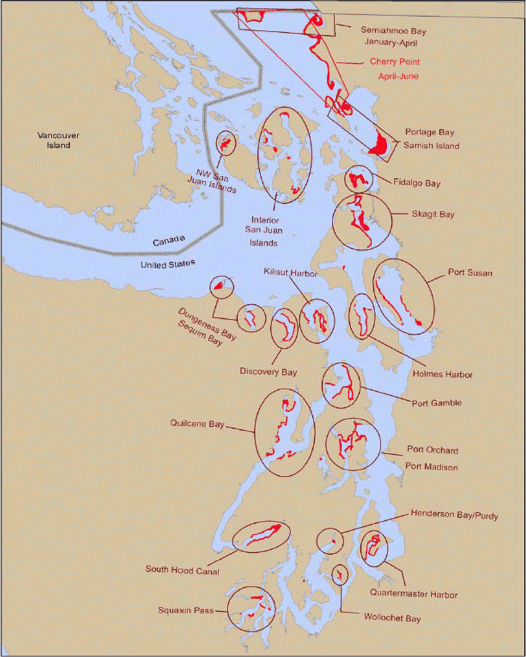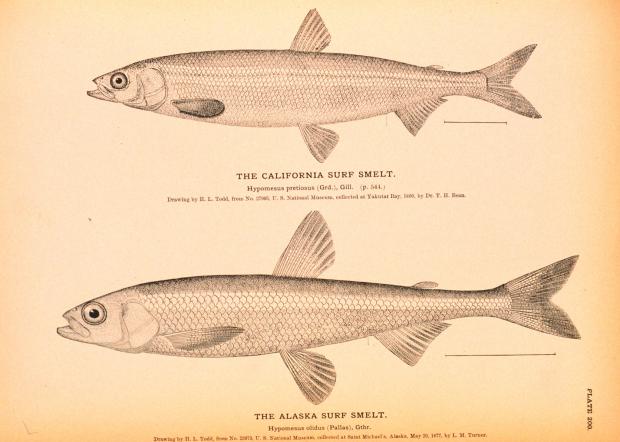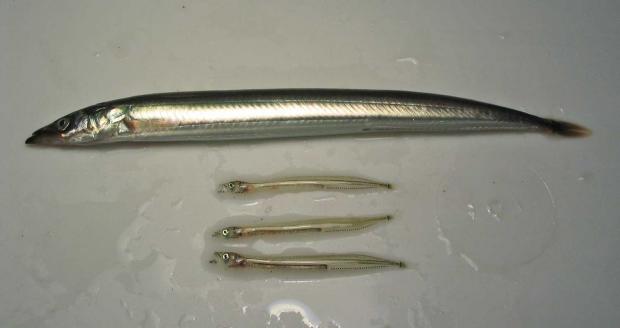Forage fish in Puget Sound
Forage fish occupy every marine and estuarine nearshore habitat in Washington, and much of the intertidal and shallow subtidal areas of the Puget Sound Basin are used by these species for spawning habitat.

Background
Forage fishes are small schooling fishes that form a critical link in the marine food web between zooplankton and larger fish and wildlife consumers. Status of forage fish populations can be an indicator of the health and productivity of nearshore systems (PSP 2009). Information on forage fish life history, distribution, and habitat preferences is summarized in Marine Forage Fishes of Puget Sound (Penttila 2007) and the Forage Fish Management Plan (Bargmann 1998).
The three most common forage fish species in the Puget Sound basin are Pacific herring (Clupea pallasi), surf smelt (Hypomesus pretiosus), and Pacific sand lance (Ammodytes hexapterus), and are therefore the focus of this section.
Pacific herring are a pelagic fish species found from northern Baja California to northern Honshu Island, Japan. They are found throughout the Puget Sound basin and are a mix of “resident” and “migratory” stocks (Gao et al. 2001, Penttila 2007, Stick and Lindquist 2009). Migratory populations cycle between the winter spawning grounds in the inside waters and the mouth of the Strait of Juan de Fuca in the summer, while resident stocks reside in the inside waters year-round (Penttila 2007). The faster individual growth rates observed in some herring populations are thought to be the result of fish leaving Puget Sound to feed in more productive oceanic waters and thus help to differentiate between migratory and resident stocks. For example, the Squaxin Pass herring population has a slower growth rate and is classified as “resident” while the Cherry Point population has a faster growth rate and is classified as “migratory” (Stick and Lindquist 2009).
Herring spawning occurs between January and April, with the majority of spawning taking place in February and March. Herring become ready to spawn over a two-month period by moving from deep water into shallow nearshore areas. The large natural and decadal oscillations in herring stock abundance are reflected in the area of spawning used annually. Most spawning areas appear to have “outlier” areas, used only during periods of high stock abundance, and “core” areas, used during periods of low stock abundance (Penttila 2007). Herring spawn on benthic marine macro-vegetation such as eelgrass or red macroalgae in the shallow subtidal and low intertidal region. Herring spawn preferentially in sheltered bays as opposed to vegetation beds on adjacent open shorelines (Stick and Lindquist 2009) (Figure 1).

Figure 1. Documented Pacific herring spawning areas in Puget Sound (reprinted from Stick and Lindquist 2009 with permission from Washington Department of Fish and Wildlife).
Within the Puget Sound basin, autonomous stocks of herring are defined as having geographically distinct spawning areas and seasons. Two herring populations are deemed genetically distinct from other Puget Sound: the Cherry Point population which is distinctive for its late spawn timing (Small et al. 2005, Beacham et al. 2008, PSP 2008) and the Squaxin Pass population (Stick and Lindquist 2009)(Figure 1), which is thought to be spatially isolated from other populations (Small et al. 2005). Other sampled herring stocks show no evidence of genetic distinction (Small et al. 2005, Beacham et al. 2008), suggesting that these stocks may be part of a metapopulation where sufficient gene flow reduces genetic divergence (Stick and Lindquist 2009). If Puget Sound herring stocks act as a metapopulation, it may be more relevant to examine abundance trends on a larger scale than individual stock level, with Cherry Point and Squaxin Pass being the exceptions (Stick and Lindquist 2009).
Surf Smelt

Surf smelt (Hypomesus pretiosus). Image courtesy of NOAA.
Surf smelt are a nearshore species found from Long Beach, California to Chignik Lagoon, Alaska. They occur throughout the marine waters of Washington and in the southernmost region of Puget Sound. For the duration of their lifespan, surf smelt appear to inhabit shallow nearshore zones in the general area of their spawning (Penttila 2007).
Surf smelt spawning habitat is distributed throughout the Puget Sound basin and over a broad variety of conditions (e.g., variable salinity or shading). Spawning areas are usually occupied during summer (May-August), fall-winter (September-March), or year-round (monthly spawning with a seasonal peak)(Bargmann 1998, Penttila 2007). Spawning beaches are used on an annual basis, and as with Pacific herring, surf smelt have been shown to utilize “outlier” spawning sites during periods of high stock abundance (Penttila 2007).
Surf smelt use predictable shoreline areas for spawning across seasons; all spawning beaches first mapped by the Washington Department of Fish and Wildlife (WDFW) in the 1930s are still used by surf smelt. The critical habitat elements for spawning are substrate and tidal elevation. Surf smelt spawn in the uppermost one-third of the tidal range and most beaches appear suitable for surf smelt spawning habitat ranging from sheltered beaches to fully-exposed pebble beaches (Penttila 2007). Due to the diffuse nature of surf smelt spawning habitat there are no obvious grounds for stock definition in geographical terms.
Pacific Sand Lance

Pacific Sand Lance (Ammodytes hexapterus). Image courtesy of the U.S.G.S.
The Pacific sand lance occurs throughout the coastal northern Pacific Ocean from the Sea of Japan to southern California, and is widespread within the nearshore marine waters of Washington, including the entire Puget Sound basin. Sand lances inhabit nearshore waters and spawn between November and February. Sites and spawning habitats of sand lance are similar to that of surf smelt: upper intertidal sand and gravel beaches. Sand lance spawning often takes place on beaches at the distal ends of drift-cells, where accretionary shoreforms tend to occur. Because sand lance and surf smelt deposit eggs in the upper intertidal, they are particularly vulnerable to shoreline habitat modifications (Bargmann 1998).
Status
Of the forage fishes reviewed in this document, only Pacific herring populations have been monitored with sufficient detail to permit status evaluation. Surf smelt and sand lance populations are generally not considered threatened or endangered yet their abundances are currently unknown (Penttila 2007, PSP 2007).
Because of the dependence of forage fish on specific macro-vegetation for spawning, both environmental conditions and human activity (e.g., nearshore development) are likely to affect forage fish spawning biomass (Penttila 2007, Stick and Lindquist 2009). For this and other reasons (e.g., the difficulty in sampling adult populations), regulations have focused on managing forage fish spawning habitat. The Washington Administrative Code (WAC) (220-110), state Growth Management Act (GMA), and WDFW Priority Habitats and Species Program (PHS) all identify forage fish habitat as priority conservation “critical areas” or “areas of concern” for forage fish management (Penttila 2007).
Pacific Herring
There are 19 different stocks of Pacific herring in Puget Sound, based on timing and location of spawning activity (Bargmann 1998, PSP 2007). For 2007-2008, less than half of Puget Sound herring stocks were classified as healthy or moderately healthy (Stick and Lindquist 2009)(Table 1). This is similar to the status breakdown for the previous two-year periods (2003-04, 2005-06). The combined spawning biomass for all Puget Sound, excluding Cherry Point, is considered moderately healthy compared to the previous 25-year mean (11,656 tons for 2007-08 compared with 16,263 tons for 25-year mean). The abundance of south and central Puget Sound herring stocks, excluding Squaxin Pass (which is considered healthy at this time), are considered moderately healthy for 2007-08 (Stick and Lindquist 2009)(Table 1). The cumulative north Puget Sound regional spawning biomasses are considered depressed. Cherry Point continues to be considered critical; spawning biomass decreased during 2007 and 2008. Fidalgo Bay has also declined significantly since 1999 (Stick and Lindquist 2009)(Table 1). The Strait of Juan de Fuca regional status has generally been classified as critical, primarily due to Discovery Bay and Dungeness/Sequim Bay stocks suffering serious declines in biomass in recent years (Table 1) (Penttila 2007, PSP 2007, Stick and Lindquist 2009).
Literature Cited
Bargmann, G. 1998. Forage Fish Management Plan. Washington Department of Fish and Wildlife, Olympia, WA.
Beacham, T. D., J. F. Schweigert, C. MacConnachie, K. D. Le, and L. Flostrand. 2008. Use of microsatellites to determine population structure and migration of Pacific Herring in British Columbia and adjacent regions. Transactions of the American Fisheries Society 137:1795-1811.
Gao, Y. W., S. H. Joner, and G. G. Bargmann. 2001. Stable isotopic composition of otoliths in identification of spawning stocks of Pacific herring (Clupea pallasi) in Puget Sound. Canadian Journal of Fisheries and Aquatic Sciences 58:2113-2120.
Penttila, D. 2007. Marine Forage Fishes in Puget Sound. Puget Sound Nearshore Partnership Report No. 2007-03, Seattle, WA.
PSP. 2007. Puget Sound Update: Ninth Report of the Puget Sound Assessment and Monitoring Program. Page 260, Olympia, WA.
PSP. 2008. Species and Biodiversity Topic Forum. Puget Sound Partnership, Seattle, WA.
PSP. 2009. Ecosystem Status & Trends. Puget Sound Partnership, Seattle, WA.
Small, M. P., J. L. Loxterman, A. E. Frye, J. F. Von Bargen, C. Bowman, and S. F. Young. 2005. Temporal and spatial genetic structure among some Pacific Herring populations in Puget Sound and the Southern Strait of Georgia. Transactions of the American Fisheries Society 134:1329-1341.
Stick, K. C., and A. Lindquist. 2009. 2008 Washington State Herring Stock Status Report. Stock Status Report No. FPA 09-05, Olympia, WA.

